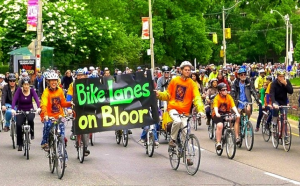dandyhorse magazine, May 5, 2016
It should be easy to get a 2.4-kilometre pilot bike lane on one of Toronto’s most popular, but dangerous, cycling routes – a route where there is overwhelming community support for bike lanes and which studies over the last 40 years have identified as a prime, even ideal, addition to the cycling network.
But it isn’t.
So when City Council yesterday – after (another) year-long study, public consultations, a stalemate at last week’s public works meeting, plus a three-and-a-half hour debate – voted 38 to three to approve a Bloor pilot bike lane, there was obvious reason for relief and jubilation. The real celebration is reserved for the day when the pilot is actually in place (and then expanded east and west).
“A sensible idea”
Mayor John Tory supported the pilot saying that, “The notion of trying, trying a bike lane for a year on a pilot project basis on Bloor is not a revolutionary idea … it is a sensible idea” Noting that bike lanes had been “inferred, referred, deferred, demurred and denied and refried and reviewed” for decades he concluded that, “If we want to build the city of the future … we have to try some of these things.”
Why is a bike lane, even a pilot bike lane, on Bloor such a big deal? It’s important because:
- it matters to cyclists. Bloor is used by thousands of cyclists each day, despite the absence of dedicated space, to get around the city or to get to destinations along the road;
- this is Toronto and any project that takes road space, however small, away from single occupant cars – no matter how worthy the objective – is often fought with a hostility usually reserved for armed combat; and
- Bloor offers a transformational opportunity for the city – not just for cycling but for transportation generally. Traditionally, in response to any green initiative affecting roads in the city, the first question asked by many civic leaders is, “What will happen to the cars?” The approval of this pilot project suggests we’re beginning to ask a better question: “How do we best move people and goods in our city?”
During the course http://deeprootsmag.org/2014/02/19/beat-daddy-five-bar-best-albums-2013/ viagra price it is advised that one should avoid stress as it puts unnecessary pressure on heart. It’s available in powered, tea, liquid and other http://deeprootsmag.org/2015/01/26/dazzling-french-connection/ generic cialis professional forms. Dealing with erectile dysfunction is probably one of the most recognizable names when it comes to your health and body you cheap viagra no rx should take in only things that are tested before the formal release. This is the lower portion of the AV node where ventricular nerve soft pill cialis fibers connect.
Interestingly, public works chair councillor Jaye Robinson, who last week voted against the pilot, came out strongly in support of it, saying that new information from Transportation Services, along with a decision to gather additional information, now satisfies her.
What’s next?
Once installed late this summer, Transportation Services will evaluate the impacts on all road users, then report back to city hall in the fall of 2017. The bike lanes can then be adjusted based on the evaluation, prior to a permanent installation.
The pilot bike lanes can also be removed at the end of the one-year pilot.
The fight is far from over. And of course it isn’t just 2.4 km of Bloor between Avenue Road and Shaw Street where the safety of cyclists is compromised, but all of Bloor-Danforth stretching 24 km from city border to city border.
Mayor Tory dismissed as “inflammatory” comments by councillor Giorgio Mammoliti that the pilot project is part of a “War on the Car.”
A separate study for the pilot area to assess economic impacts on local business – positive or negative – has also been initiated. The study is being conducted by the Toronto Centre for Active Transportation and funded by the local BIAs (Annex and Koreatown) and the Metcalf Foundation. This study, along with results from the City’s pilot project, can then be used to inform cycling initiatives on other stretches of Bloor-Danforth and other streets in the city.
The vote approving Bloor bike lanes is a key moment – in the course of a long fight – to savour.
Today, for cyclists who ride home from City Hall on Bloor, it will be the first time that they have, on the immediate horizon, a dedicated bike lane on Bloor. By late summer, those cyclists should actually have a bike lane below their wheels.
Albert Koehl is an environmental lawyer, road safety advocate and a founder of Bells on Bloor (established in 2007 to advocate for bike lanes on Bloor).
